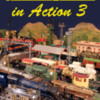Tinplate Legends in Action – Part 3: the John DeSantis collection and layouts.
During the layout tours of the 50th AnniversaryTCA Convention in Pittsburgh, an extremely fortunate subset of attendees had the privilege of visiting the home of John DeSantis and viewing his magnificent collection of the prewar Standard and Wide gauge trains. I was one of the lucky ones and the majestic collection made a lasting impression. We have here a marvelous new video tour devoted in its entirety to the fabulous DeSantis Standard gauge tinplate collection and, for some of us, a keepsake from a memorable visit of eight years ago. John, himself, narrates much of this video tour in an engaging and avuncular fashion.
John received his first train for Christmas at the age of two. It was a Lionel Standard gauge set. He continued to add to his collection of trains and accessories as a young man to enhance his holiday layouts and has been adding to his collection for over 60 years. John credits his obtaining, as a youth, a copy of Carstens’ “History of Lionel Standard Gauge” as a revelation. While at Georgetown University, he providentially met Graham Clator (later the first president of Amtrak) one of the legendary early tinplate collectors – a meeting which opened up the social vistas of tinplate collecting to the likes of Louis Hertz, Lou Redman, and Ward Kimball.
The collection encompasses samples of virtually all of the pieces and their variations manufactured by the American “Big Three” plus many of ‘the others’. The collection and layouts are housed in the top two floors of a beautifully restored stone Victorian townhouse. The displays are organized into rooms not unlike a museum; these include the Lionel room, the American Flyer room, the Ives room, and a room for the manufacturers of lesser numbers (but not of lesser quality!), such as Dorfan, Boucher, and General. Displayed thusly, this is the only place one can compare the development of different lines of large tinplate toy trains and directly compare the lines of different manufacturers over the first third of the 20th Century.
John believes that the boundary between collecting and operating is a hazy one at best. The layout is actually four layouts, on which the trains, track, power sources, and accessories of each of the major prewar tinplate manufacturers are assembled -- each layout purely of one brand of Standard gauge tinplate. This permits one to physically view in operation the ‘look’ and aesthetics created by Lionel, American Flyer, or Ives, as originally created in their respective catalogs.
The collection contains over 300 preproduction prototypes and factory color samples. These include the original No. 5 steam profile locomotive that appears on the back cover of the 1940 catalog, a prototype of a coal tender for the 400E, preproduction ‘State’ cars with name plates of realPullmans. Examples of all of the Lionel trolleys are to be seen, including the truly rare No. 9. All of the variations of every major set are there to be seen. Ives rarities include all the variations of the Ives white sets and the John Wanamaker sets. American Flyer rarities include all fifteen of the Presidents Special variations, the Mayflower, the five window caboose, the original 3235St. Paulpreproduction prototype, a switching engine with 6-wheel trucks, and an electrically operated baggage car. The two versions of the Lionel Harmony Creamery cars: the Lionel No. 14 green boxcar fitted with milk tanks and the Ives flat cars fitted with two tanks. To call the collection of boxes that go with the trains extensive and comprehensive is an understatement.
The tour is concluded with a Million Dollar shot of the Icons. The roster includes a Boucher Blue Comet, a Mayflower set by Chicago AF, an Ives Prosperity Special, a unusual green No. 408 by Lionel, a Maerklin Standard gauge steam locomotive, an Ives white set steam locomotive, an Ives Transition Era Olympian, and a Dorfan Florida Limited.
Some of John’s Standard gauge tinplate is shown in operation in the following utube video, including the Million Dollar shot and a tongue-in-cheek Classic Era TM ‘Oh, no”.
The HD video production by TM of my pre-release version is great as usual, and light classical music is used to provide an effective and evocative atmosphere.
Even the most blasé will be gob-struck by what is to be viewed in this video tour. The stories of the trains are inextricably linked to the telling of a charming personal life journey of an avid collector. The production is arguably one of the most significant videos done by TM since the “Century of Lionel”.
Bob Bubeck






